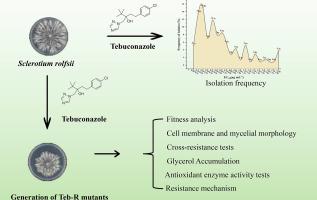Molecular and biological characteristics of laboratory tebuconazole-resistant mutants in Sclerotium rolfsii
IF 4
1区 农林科学
Q2 BIOCHEMISTRY & MOLECULAR BIOLOGY
引用次数: 0
Abstract
Peanut southern blight, caused by Sclerotium rolfsii Sacc., significantly reduces both global yield and quality of peanut. Tebuconazole, a triazole fungicide, effectively inhibits S. rolfsii, but its resistance risk and molecular mechanisms remain unclear. In the present study, the EC50 values for tebuconazole against 210 S. rolfsii isolates ranged from 0.0651 to 5.772 mg L−1 with sensitivity exhibiting a multimodal distribution. Four tebuconazole-resistant mutants (Resistance factor: 17.50–33.50-fold) generated by laboratory adaptation showed fitness costs in salt tolerance and virulence, with diminished exopolysaccharide production. However, no fitness costs were observed in mycelial growth rate or sclerotia production compared to their corresponding parental strains. Tebuconazole showed positive cross-resistance with fluxapyroxad but negative with cyprodinil. No cross-resistance occurred to boscalid, thifluzamide, isopyrazam, prothioconazole, pyraclostrobin, fludioxonil, difenoconazole, epoxiconazole, azoxystrobin, propiconazole, fluxapyroxad or pydiflumetofen. The resistant mutants showed overexpression of the SrCYP51 gene, elevated ergosterol and glycerol content, but significantly reduced activities of peroxidase, superoxide dismutase, and catalase. These findings indicate that tebuconazole-resistant strains of S. rolfsii have emerged under field conditions. The overexpression of the SrCYP51 gene and elevated ergosterol levels may contribute to tebuconazole resistance in S. rolfsii. These findings elucidate S. rolfsii's tebuconazole resistance mechanism and provide field-applicable strategies to mitigate resistance evolution.

罗尔夫菌核菌实验室抗替布康唑突变体的分子生物学特性
花生南枯萎病,由菌核菌引起。,显著降低了全球花生产量和品质。三唑类杀菌剂Tebuconazole能有效抑制S. rolfsii,但其耐药风险及分子机制尚不清楚。在本研究中,戊康唑对210株罗尔夫氏沙门氏菌的EC50值范围为0.0651 ~ 5.772 mg L−1,敏感性呈多模态分布。通过实验室适应产生的4个抗替布康唑突变体(抗性因子:17.50 - 33.50倍)显示出耐盐性和毒力方面的适应度成本,同时胞外多糖产量减少。然而,与相应的亲本菌株相比,在菌丝生长速度或菌核产量方面没有观察到适应度成本。替布康唑与氟沙吡沙交叉耐药呈阳性,与赛普罗尼交叉耐药呈阴性。对氟唑胺、硫氟酰胺、异吡嗪、原硫康唑、吡氯菌酯、氟氧恶菌酯、异苯唑、环氧康唑、氮氧菌酯、丙环康唑、氟嘧菌酯、氟嘧菌酯、氟嘧菌酯、氟嘧菌酯、氟嘧菌酯、氟嘧菌酯、氟嘧菌酯和吡氟甲醚均无交叉耐药。抗性突变体表现出SrCYP51基因的过表达,麦角甾醇和甘油含量升高,但过氧化物酶、超氧化物歧化酶和过氧化氢酶活性显著降低。这些结果表明,在田间条件下已经出现了耐替布康唑菌株。SrCYP51基因的过表达和麦角甾醇水平的升高可能是S. rolfsii对戊康唑耐药的原因之一。这些发现阐明了S. rolfsii对戊康唑的耐药机制,并为减轻耐药进化提供了适用于田间的策略。
本文章由计算机程序翻译,如有差异,请以英文原文为准。
求助全文
约1分钟内获得全文
求助全文
来源期刊
CiteScore
7.00
自引率
8.50%
发文量
238
审稿时长
4.2 months
期刊介绍:
Pesticide Biochemistry and Physiology publishes original scientific articles pertaining to the mode of action of plant protection agents such as insecticides, fungicides, herbicides, and similar compounds, including nonlethal pest control agents, biosynthesis of pheromones, hormones, and plant resistance agents. Manuscripts may include a biochemical, physiological, or molecular study for an understanding of comparative toxicology or selective toxicity of both target and nontarget organisms. Particular interest will be given to studies on the molecular biology of pest control, toxicology, and pesticide resistance.
Research Areas Emphasized Include the Biochemistry and Physiology of:
• Comparative toxicity
• Mode of action
• Pathophysiology
• Plant growth regulators
• Resistance
• Other effects of pesticides on both parasites and hosts.

 求助内容:
求助内容: 应助结果提醒方式:
应助结果提醒方式:


